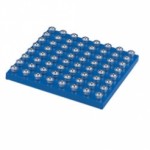Ball transfer tables have load bearing spherical balls that are omni directional which are mounted inside of a restraining device. Each of the large balls that make up the ball transfer table is usually supported by smaller ball bearings in hemispherical cup. The balls are mostly used in an inverted position while items or products are quickly moved over the transfer table which is the least problematic. This allows the manual transfer of items or products from different sections of other conveyor systems.
Ball transfer tables can be made of nylon, steel, stainless steel, or carbon with the ball transfers made of stainless steel, steel, or carbon steel. They are made with a variety of different products in mind and have different load capacities, heights, and widths. Stainless steel units are usually reserved for the food processing industry while for sanitary purposes. The nylon ball types are usually applied in instances where softer products are being produced or shipped to prevent damage.
Although ball transfer tables are key to conveyor systems they have been found to by highly effective in other areas of the industry. It may be surprising to some to find that ball transfer tables are now being used as an alternative for moving dollies. Moving displays or other items in a department store, dining hall, concert hall, or show rooms. They place the ball transfer unit ball side down and place the item on top for relocation. Of course this is not very effective for moving items over semi rough terrain like sidewalks or what not, but it is very effective inside on smooth floors and carpet.
Ball transfer tables have been referred to as ball transfer systems, ball transfer conveyors, or just plain old ball transfers. Regardless of which term you use to describe the unit the fact remains that they are a very important part of any conveyor system.

